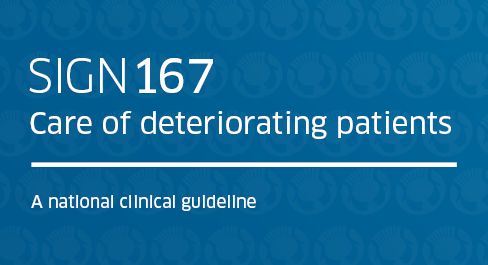Care of deteriorating patients
This guideline focuses on the management of acute clinical deterioration in non-pregnant adult patients within primary, secondary and community care settings.
The guideline replaces SIGN 139: Care of deteriorating patients.
Who this guideline is for
This guideline will be of interest to:
- healthcare professionals who are involved in the care of deteriorating patients in all settings
- relatives and carers of deteriorating patients
- service commissioners.
A plain language summary of the guideline is due for publication in August 2023.
Recommendations
Planning and decision making
- All patients at risk of clinical deterioration should have a documented anticipatory care plan that is completed with input from the patient and their family. Documented plans should be accessible to all care providers.
- The anticipatory care plan should include a decision on cardiopulmonary resuscitation in the event of cardiac or respiratory arrest.
- Cardiopulmonary resuscitation status should not be the sole focus of the anticipatory care plan.
- A treatment escalation plan should be formulated for patients at risk of clinical deterioration where the risks or benefits of certain therapies may be in doubt. The treatment escalation plan should be formulated with input from the patient and their family.
- The treatment escalation plan should incorporate a decision about cardiopulmonary resuscitation in the event of cardiac or respiratory arrest.
- Cardiopulmonary resuscitation status should not be the sole focus of the treatment escalation plan.
- The treatment escalation plan should include a comment on the patient’s medically assessed suitability for advanced therapy should further deterioration occur.
- Good practice point: Treatment escalation plans should be reviewed regularly if the patient’s clinical status is changing.
Recognition of clinical deterioration
- Observations should be transcribed electronically, charted electronically and displayed electronically and be underpinned by effective information technology (IT) systems, protocols and support to ensure ease of use. Appropriate paper-based systems should be readily available as a safeguard in the event of IT failure.
- Within an acute care setting, consider the use of automated prompts based on NEWS2 or other criteria alongside traditional methods of escalating care (such as direct telephone calls or paging systems). Implementation of such systems relies on adequate staffing resource to manage the generated automated alerts.
Early warning scores
- NEWS2 should be used to monitor all acutely ill adult patients in prehospital, emergency department, acute hospital and community settings.
Sepsis
-
The management of the deteriorating adult patient with a suspicion of sepsis within the emergency department and hospital setting should be based on the National Early Warning Score 2 (NEWS2). The clinical decision support framework developed by AoMRC should be used. The framework provides a severity score based on NEWS2 bands of 0, 1–4, 5–6 and ≥7. This severity score should be interpreted in the light of clinical assessment, rapidity of deterioration, likely diagnosis, immune status and evidence of organ dysfunction. At time zero, defined as the time of the first NEWS2 assessment on presentation to the emergency department or ward deterioration, the administration of appropriate antimicrobials should be completed within:
- 6 hours of recording a NEWS2 score of 1–4 for patients with possible infection
- 3 hours of recording a NEWS2 score of 5–6 for patients with probable infection, or
- 1 hour of recording a NEWS2 score ≥7 for patients with definite infection.
- Consult local antimicrobial policy for empirical therapy.
- Good practice point: The AoMRC clinical decision support framework should be extended to such instances when the right monitoring of antimicrobials is available within community or primary care.
Response to deterioration
- Use of a structured response tool could be considered for deteriorating patients in hospital. The structured response does not replace clinical judgement, but can outline elements required, such as minimum frequency of observations, time to review by an appropriate healthcare professional and what to do if the patient deteriorates despite review.
- A critical care outreach team to support the response to the deteriorating patient in hospital settings should be considered. Where this is not possible, there should be clear escalation guidelines and a senior decision maker should be available to assist the deteriorating patient.
Handover communication
- Standardised structured handovers should be used in all areas of clinical care.
- Development of checklists appropriate to the clinical setting and workload should be considered as an aide memoire when needed alongside a structured handover.
How this guideline was developed
This guideline was developed using a standard methodology based on a systematic review of the evidence. Where studies were too limited to support an evidence-based conclusion, a modified Delphi process was used to vote on consensus statements developed by the guideline development group. Further details can be found in SIGN 50: A Guideline Developer’s Handbook.
Keeping up to date
This guideline was published in 2023 and will be considered for review in three years.
![]() Current < 3 years
Current < 3 years
